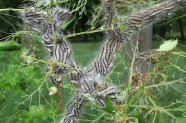Forschungs- und Innovationsprojekt
Modellgestützte Gefährdungsabschätzung des Eichenprozessionsspinners im Klimawandel (ModEPSKlim)
| Status: | abgeschlossen |
| Laufzeit: | 01.03.2016 – 30.04.2019 |
| Projektkoordination: | Paula Halbig, Forstliche Versuchs- und Forschungsanstalt Baden-Württemberg (FVA), Abteilung Waldschutz |
| Projektleitung LWF: | Dr. Gabriela Lobinger |
| Durchführende Institutionen: | Nordwestdeutsche Forstliche Versuchsanstalt (NW-FVA); Bayerische Landesanstalt für Wald und Forstwirtschaft (LWF); Landeskompetenzzentrum Forst Eberswalde (LFE); Julius Kühn-Institut Darmstadt (JKI) |
| Finanzierung: | Bundesanstalt für Landwirtschaft und Ernährung (BLE); Waldklimafonds |
Kurzbeschreibung
 Zoombild vorhanden
Zoombild vorhanden
Foto: R. Petercord, LWF
Aus diesem Grund soll im Zuge des Projekts „ModEPSKlim“ ein Online-Frühwarnsystem zur regional differenzierten Einschätzung der aktuellen Entwicklungsbedingungen (Phänologie) und Populationsdichten des EPS sowie der daraus resultierenden Gefahren für Wald und menschliche Gesundheit entwickelt werden. Durch die Verknüpfung phänologischer und populationsdynamischer Grundlagen der EPS-Entwicklung mit der Ausbreitung der Gifthaare in der Luft in Abhängigkeit von räumlicher Entfernung, Witterung und Wetterprognose wird das gegenwärtige und zukünftige Risiko von Gifthaarbelastungen und Fraßschäden der Raupen abschätzbar.
Die Nutzung des Modells, welches prinzipiell eine Anwendbarkeit im gesamten Verbreitungsgebiet des EPS vorsieht, ermöglicht und erleichtert somit eine zeitgerechte und effektive Durchführung präventiver und regulierender Maßnahmen im Hinblick auf Pflanzenschutz und Gesundheitsschutz des Menschen.
The increasing occurrence of oak processionary moth (OPM), Thaumetopoea processionea L., in Central Europe since the 1990s is possibly linked to the current climate change. In view of recent RCP-scenarios of IPCC, the existing need for recommendations and solutions for development prediction and reduction of OPM related danger will prospectively further enhance. Besides the risk for host trees due to defoliation by the caterpillars, larval produced urticating hairs (setae) are particularly considered as relevant threat, since they can severely affect human health.
Therefore, an online early warning system for regionally differentiated evaluation of development conditions (phenology) and population density of OPM and the associated risk for forests and human health should be developed in the course of the project “ModEPSKlim”. Through combination of basics in phenology and population dynamics of OPM with aerial spread of setae dependent from spatial distance and weather (forecast), current and future threat of setae pollution and defoliation by the caterpillars is predictable.
Hence, the model – which is applicable to the whole range of OPM – enables a timely and effective application of preventive and regulatory measures with respect to oak tree and human health protection.



